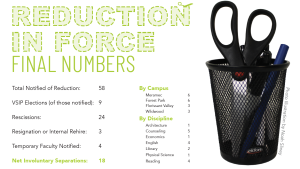Changes still expected after heavy mitigation from ‘successful’ voluntary separations
BY: Melissa Wilkinson
Editor-in-Chief
Mid-March 2018, the final numbers of the reduction in force are in. Only 18 of the initial 58 fulltime faculty that received reduction notices in December will actually lose their jobs at the end of the spring semester.
in force are in. Only 18 of the initial 58 fulltime faculty that received reduction notices in December will actually lose their jobs at the end of the spring semester.
The number is a result of what Chancellor Jeff Pittman called a “successful” Voluntary Separation Incentive Program campaign. Over 100 faculty and staff elected to voluntarily separate, heavily mitigating those who were involuntarily cut.
According to Andrew Langrehr, Vice Chancellor of Academic Affairs, the notices were rescinded based on how many VSIPs were taken in a certain discipline. This is how some disciplines, like physical education, ended up with no cuts, but disciplines like English and reading, which comprised of collectively almost half of the original 58 cuts, ended up with several faculty that could not be spared.
“If there were x number of English faculty who got a reduction in force notice and y number of English faculty took the VSIP and y ended up being equal to x, they would cancel each other out,” said Langrehr. “But in English there weren’t enough people who took the VSIP to rescind all of the folks who were RIF’ed so what we did is we used some VSIPs in disciplines where nobody
was RIF’ed.”
While Langrehr called this “a humane approach”, Forest Park English professor Melody Gee said that the move was “completely backwards.”
“It should not have been a reactionary move. Why would you [reduce] people and then offer the retirement?” said Gee. “Rather than dealing with the budget crisis with a forceful VSIP, with cash incentives like they did after the RIFs, they did the RIF first. That’s not how you handle a budget crisis. It says to the community, the first priority is cutting faculty.”
Gee is one of the 18 faculty who did not have her RIF notice rescinded. She has been outspoken in her disdain of STLCC’s administration, publishing several articles in the St. Louis Post Dispatch.
While there was a VSIP offered during the summer of 2017, immediately following Pittman’s announcement that there might be faculty cuts due to a decrease in core funding, Gee said the original benefits were “so ridiculous” that not a lot of people accepted the VSIP.
Langrehr is also in the process of evaluating the need to transfer faculty between campuses, something he said is likely.
“Over time the college hasn’t done a good job of making sure that equilibrium is balanced. It’s been more campus-centric, said Langrehr. “Right now is a time that we can look at those things and see that it’s fair for the students, that they all have equal opportunity to have full-time faculty in their classes. I think that there’s a chance that some people will be transferred. … And there are people who are interested. I’ve had a lot of people lining up because they’re itching to move from campus x to campus y.”
STLCC National Education Association (NEA) President Rob Hertel met with Langrehr on Friday, March 23 to discuss the matter. Hertel said that next week, Langrehr will email faculty asking if anyone would like to voluntarily transfer campuses, moving forward with involuntary transfers if the need is not met voluntarily. He predicts the number of moves will be between one and 15.
According to Hertel, some of his colleagues have accepted the results of the reduction in force. Others are still “agitated” about it. But some, like Gee, are doing their best to move on.
“I’m taking some time to explore my options,” said Gee. “I thought I would retire at Forest Park. That was my lifelong goal. I’m still in the middle of mourning that loss and moving forward at the same time.”










